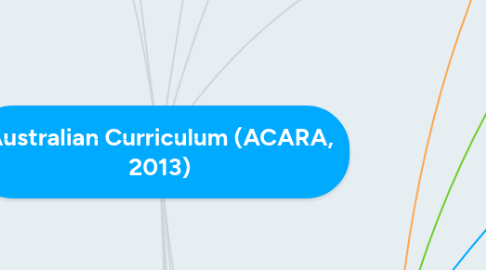
1. Learning Areas
1.1. Mathematics
1.1.1. Strands
1.1.1.1. Number and Algebra
1.1.1.2. Measurement and Geography
1.1.1.3. Statistics and Probability
1.2. Science
1.2.1. Strands
1.2.1.1. Science Understanding
1.2.1.2. Science as a Human Endeavour
1.2.1.3. Science Inquiry skills
1.3. Humanities and Social Sciences
1.3.1. Subjects
1.3.1.1. Geography
1.3.1.2. History
1.3.1.3. Economics and Business
1.3.1.4. Civics and Citizenship
1.4. English
1.4.1. Strands
1.4.1.1. Language
1.4.1.2. Literacy
1.4.1.3. Literature
1.5. The Arts
1.5.1. Subjects
1.5.1.1. Dance
1.5.1.2. Drama
1.5.1.3. Media Arts
1.5.1.4. Music
1.5.1.5. Visual Arts
1.6. Health and Physical Education
1.6.1. Strands
1.6.1.1. Movement and Physical Activity
1.6.1.2. Personal, Social and Community Health
1.7. Languages
1.7.1. Strands
1.7.1.1. Communicating
1.7.1.2. Understanding
1.8. Technologies
1.8.1. Subjects
1.8.1.1. Design and Technologies
1.8.1.2. Digital Technologies
2. Organisation
2.1. Content descriptors
2.2. Content elaborations
2.3. Achievement standards
3. Cross Curriculum Priorities
3.1. Aboriginal and Torres Strait Islander histories and cultures
3.1.1. Provides creative, engaging and diverse learning contexts for students to value and appreciate the contribution by the world's olded living cultures to past, present and emerging technologies
3.2. Asia and Australia's engagement with Asia
3.2.1. Provides diverse and authentic contexts to develop knowledge and understanding of technologies processes and productions and related cultural, social and ethical issues
3.3. Sustainability
3.3.1. Provides authentic contexts for creating preferred futures and prepares students to take action
4. General Capabilities
4.1. Literacy
4.1.1. Literacy of technologies
4.2. Numeracy
4.2.1. Opportunities to interpret and use math knowledge and skills in a range of real-life situations
4.3. Critical and creative thinking
4.3.1. About possible, probable and preferred futures
4.4. Information and communication Technology capability
4.4.1. Develop ICT capability to effectively and appropriately access, create and communicate information and ideas, solve problems and work collaboratively, and in their lives beyond school.
4.5. Personal and social capability
4.5.1. Develop social awareness and an understanding of diversity by researching and identifying user needs; consider past and present impacts of decisions
4.6. Ethical understanding
4.6.1. Capacity to understand and apply ethical and socially responsible principles when collaborating with others and creating, sharing and using technologies
4.7. Intercultural understanding
4.7.1. Consider how technologies are used in diverse communities at local, national, regional and global levels
5. Student Diversity
5.1. Gifted and talented students
5.1.1. Include content from later band levels in the Australian Curriculum Technologies
5.2. English as an additional language or dialect
5.2.1. Explicit teaching, additional time and support while students learn a new language, skills and content
5.3. Students with a disability
5.3.1. Make adjustments to delivery of some practical aspects of lessons (eg. modified tools/materials)
6. Technologies
7. AIMS
7.1. Apply knowledge and practical skills; Create innovative solutions; Work independently and collaboratively; Meet current and future needs
8. Design and Technologies
8.1. Involves using design thinking and teaching to generate and produce designed solutions for authentic needs and opportunities
8.1.1. Strands
8.1.1.1. Knowledge and understanding
8.1.1.1.1. Technologies and society
8.1.1.1.2. Technologies contexts
8.1.1.2. Processes and production skills
8.1.1.2.1. Creating designed solutions by:
9. Digital Technologies
9.1. Involves using computational thinking and information systems to define, design and implement digital solutions
9.1.1. Strands
9.1.1.1. Knowledge and understanding
9.1.1.1.1. Digital systems
9.1.1.1.2. Representation of data
9.1.1.2. Processes and productions skills
9.1.1.2.1. Creating digital solutions by:
